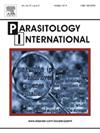Trends and forecasting of cysticercosis burden in South Asia: Insights from global burden of disease data (1990–2021)
IF 1.9
4区 医学
Q3 PARASITOLOGY
引用次数: 0
Abstract
Cysticercosis, caused by Taenia solium larvae, is a neglected tropical disease endemic in more than 75 countries of the world. It significantly contributes to epilepsy in regions with poor sanitation and inadequate food safety practices. This study aims to examine the trends in cysticercosis burden in South Asia (SA) from 1990 to 2021 using prevalence and disability-adjusted life years (DALYs) rates, and to forecast the disease burden up to 2031. Data from Global Burden of Disease (GBD) (1990–2021) was utilized to estimate DALYs and prevalence rates. Trend analysis was done by Joinpoint regression to detect temporal changes in cysticercosis. Future burden projections used the Autoregressive Integrated Moving Average (ARIMA) model, forecasting through 2031. The highest prevalence rates of cysticercosis per 100,000 population in the SEA region were recorded in Nepal, followed by Bhutan, and India, however, the trends differed from country to country. There was marked reduction in the disease burden from 1990 to 2021 across SA region, with India and Nepal achieving the highest numerical reductions in prevalence (47.38 and 39.91 respectively). Forecasting suggests a consistent overall reduction in both prevalence (50.55 to 42.14), and DALYs (14.35 to 10.58) from 2022 to 2031 respectively in the SA region. Despite an overall reduction in prevalence and DALYs, disparities in the cysticercosis burden in the different SA countries were observed. The forecasting predicted that though cysticercosis burden is expected to reduce, but it is likely to remain a major public health problem. Thus, the control of the disease will need continued efforts to enhance sanitation, health education, and pig husbandry management, integrated into the national health systems of the countries.

南亚囊虫病负担的趋势和预测:来自全球疾病负担数据的见解(1990-2021)
由猪带绦虫幼虫引起的囊虫病是一种被忽视的热带病,在世界上超过75个国家流行。在卫生条件差和食品安全做法不充分的地区,它会严重导致癫痫。本研究旨在利用患病率和残疾调整生命年(DALYs)率,研究1990年至2021年南亚(SA)囊虫病负担的趋势,并预测到2031年的疾病负担。利用全球疾病负担(GBD)(1990-2021)的数据来估计伤残调整生命年和患病率。采用关节点回归进行趋势分析,以检测囊虫病的时间变化。未来负担预测使用自回归综合移动平均(ARIMA)模型,预测到2031年。在东南亚区域,每10万人中囊虫病患病率最高的是尼泊尔,其次是不丹和印度,然而,各国的趋势不同。从1990年到2021年,整个南亚地区的疾病负担显著减少,其中印度和尼泊尔的患病率下降幅度最大(分别为47.38%和39.91)。预测表明,从2022年到2031年,南非地区的患病率(50.55至42.14)和DALYs(14.35至10.58)将分别持续总体下降。尽管流行率和伤残调整生命年总体上有所下降,但在非洲南部非洲不同国家中,囊虫病负担存在差异。该预测预测,虽然囊虫病负担有望减轻,但仍有可能成为主要的公共卫生问题。因此,该疾病的控制将需要继续努力加强卫生、健康教育和养猪管理,并将其纳入各国的国家卫生系统。
本文章由计算机程序翻译,如有差异,请以英文原文为准。
求助全文
约1分钟内获得全文
求助全文
来源期刊

Parasitology International
医学-寄生虫学
CiteScore
4.00
自引率
10.50%
发文量
140
审稿时长
61 days
期刊介绍:
Parasitology International provides a medium for rapid, carefully reviewed publications in the field of human and animal parasitology. Original papers, rapid communications, and original case reports from all geographical areas and covering all parasitological disciplines, including structure, immunology, cell biology, biochemistry, molecular biology, and systematics, may be submitted. Reviews on recent developments are invited regularly, but suggestions in this respect are welcome. Letters to the Editor commenting on any aspect of the Journal are also welcome.
 求助内容:
求助内容: 应助结果提醒方式:
应助结果提醒方式:


